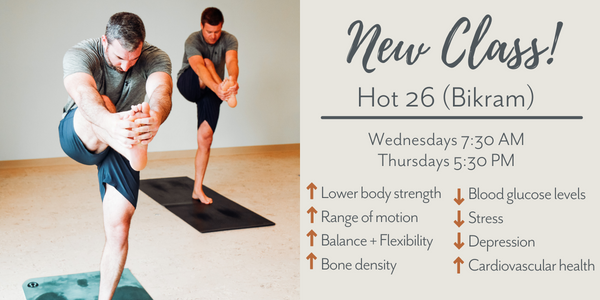8 Reasons to Practice Hot 26
What is Hot 26?
While Hot 26 is practiced in a heated room (about 100-105 degrees), it's not the same as Hot Vinyasa. Hot 26 is a series of 26 postures and 2 breathing exercises developed by Bikram Choudhury, who brought the practice to the U.S. from Calcutta, India in the 1970s. The postures are performed in the same order each class. It does not include postures or movements like downward dog, chaturanga, upward dog, and plank. Each posture is held stationary for 30-60 seconds.
The practice was developed to benefit certain systems of the body in a specific order, to aid relaxation of the mind and improve physical fitness. While a heated practice can be more challenging than unheated, its benefits are worthwhile when done correctly and safely.
What are the benefits of Hot 26 and Hot Yoga?
Studies have shown the following benefits from Hot Yoga
Improved lower body strength
Increased range of motion
Improved balance and flexibility
Increased bone density
Decreased blood glucose levels
Decreased stress
Nourished skin
Increased cardiovascular health
Who should practice Hot Yoga?
Hot 26 is a beginner class. If you're in good health, it is generally safe with some precautions in mind
Dehydration is a major concern with hot yoga. Drinking water before, during, and after a hot yoga class is essential. A low-calorie sports drink may also help restore electrolytes lost during your hot yoga workout. We recommend not drinking alcohol at least 2-3 days prior to your hot yoga class.
Those with pre-existing health conditions like heart disease, diabetes, arterial abnormalities, anorexia nervosa, and a history of fainting would make you more prone to passing out in a hot room
If you have low blood pressure or low blood sugar, you may be prone to dizziness or lightheadedness in Hot Yoga. Check with your doctor first.
Pregnant women should consult their doctor first.
If you've had heat intolerance problems in the past, you may want to stick with yoga at a normal temperature. We have plenty of classes at room temperature. View our schedule
If you begin to feel lightheaded, dizzy or nauseous, stop, take child's pose and rest. Do not leave the room until you no longer feel dizzy or lightheaded for safety reasons.
Why is it important to learn from a trained and certified teacher?
The Bikram practice was originally taught as a "dialogue" with an instructor memorizing the cues for each posture over the course of 9 weeks with Bikram and his assistants. Today, some instructors still simply learn the script and teach from it without diving deeper into how those directions and shapes can affect the body when performed over and over, and without consideration for anatomical differences or challenges some bodies may have "achieving" the posture.
A skilled teacher watches each student and makes personalized adjustments while considering anatomical differences and offering appropriate and beneficial modifications. If you're unsure of your instructor's training, ask him or her the lineage of their training.
Your Soul Society instructor, Julia Collins learned from Cindy Lunsford and Jimmy Barkan, who both trained with Bikram. In fact, Jimmy was one of Bikram's lead teacher trainers through the 80s and 90s. Cindy was Jimmy's assistant for five years.


